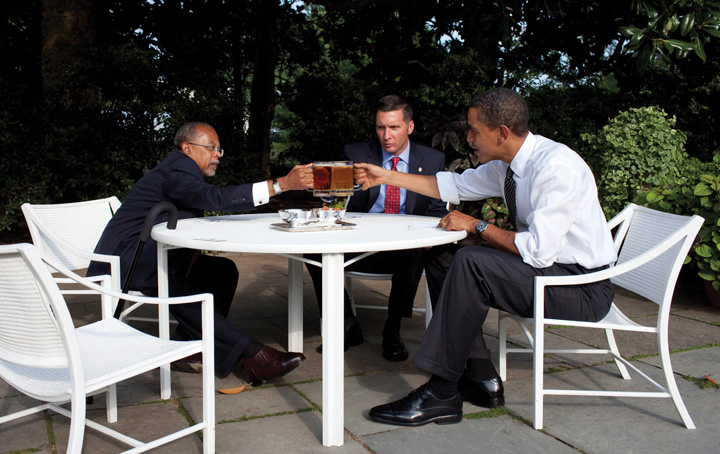This is “Discrimination”, section 10.4 from the book Sociology: Comprehensive Edition (v. 1.0). For details on it (including licensing), click here.
For more information on the source of this book, or why it is available for free, please see the project's home page. You can browse or download additional books there. To download a .zip file containing this book to use offline, simply click here.
10.4 Discrimination
Learning Objectives
- Discuss Merton’s views on whether prejudice and discrimination always coincide.
- Distinguish between individual discrimination and institutional discrimination.
- Provide two examples of institutional discrimination.
Often racial and ethnic prejudice lead to discrimination against the subordinate racial and ethnic groups in a given society. DiscriminationThe arbitrary denial of rights, privileges, and opportunities to members of subordinate racial and ethnic groups. in this context refers to the arbitrary denial of rights, privileges, and opportunities to members of these groups. The use of the word arbitrary emphasizes that these groups are being treated unequally not because of their lack of merit but because of their race and ethnicity.
Usually prejudice and discrimination go hand-in-hand, but Robert Merton (1949)Merton, R. K. (1949). Discrimination and the American creed. In R. M. MacIver (Ed.), Discrimination and national welfare (pp. 99–126). New York, NY: Institute for Religious Studies. stressed that this is not always the case. Sometimes we can be prejudiced and not discriminate, and sometimes we might not be prejudiced and still discriminate. Table 10.1 "The Relationship Between Prejudice and Discrimination" illustrates his perspective. The top-left cell and bottom-right cells consist of people who behave in ways we would normally expect. The top-left one consists of “active bigots,” in Merton’s terminology, people who are both prejudiced and discriminatory. An example of such a person is the white owner of an apartment building who dislikes people of color and refuses to rent to them. The bottom-right cell consists of “all-weather liberals,” as Merton called them, people who are neither prejudiced nor discriminatory. An example would be someone who holds no stereotypes about the various racial and ethnic groups and treats everyone the same regardless of her/his background.
Table 10.1 The Relationship Between Prejudice and Discrimination
| Prejudiced? | ||
| Discriminates? | Yes | No |
| Yes | Active bigots | Fair-weather liberals |
| No | Timid bigots | All-weather liberals |
Source: Adapted from Merton, R. K. (1949). Discrimination and the American creed. In R. M. MacIver (Ed.), Discrimination and national welfare (pp. 99–126). New York, NY: Institute for Religious Studies.
The remaining two cells of the table in Table 10.1 "The Relationship Between Prejudice and Discrimination" are the more unexpected ones. On the bottom left, we see people who are prejudiced but who nonetheless do not discriminate; Merton called them “timid bigots.” An example would be white restaurant owners who do not like people of color but still serve them anyway because they want their business or are afraid of being sued if they do not serve them. At the top right, we see “fair-weather liberals”: people who are not prejudiced but who still discriminate. An example would be white store owners in the South during the segregation era who thought it was wrong to treat blacks worse than whites but who still refused to sell to them because they were afraid of losing white customers.
Individual Discrimination

Sociologist Joe Feagin’s study of middle-class African Americans found that many had been harassed by police and otherwise had experienced various kinds of racial slights.
© Thinkstock
The discussion so far has centered on individual discriminationDiscrimination that individuals practice in their daily lives., or discrimination that individuals practice in their daily lives, usually because they are prejudiced but sometimes even if they are not prejudiced. Examples of individual discrimination abound in today’s world. The slights and indignities John Howard Griffin suffered in his experiment some 40 years ago ended when he went back to being white, but people of color do not have the luxury of switching their race or ethnicity. For them, individual discrimination by whites is a routine occurrence.
Joe Feagin (1991),Feagin, J. R. (1991). The continuing significance of race: Antiblack discrimination in public places. American Sociological Review, 56, 101–116. a former president of the American Sociological Association, documented such discrimination when he interviewed middle-class African Americans about their experiences. Many of the people he interviewed said they had been refused service, or at least received poor service, in stores or restaurants. Others said they had been harassed by the police, and even put in fear of their lives, just for being black. Feagin concluded that these examples are not just isolated incidents but rather reflect the larger racism that characterizes U.S. society. To many observers, the arrest of Henry Louis Gates Jr., a renowned African American scholar at Harvard University, at his home in July 2009 was another example of individual discrimination. Gates had returned home after a trip and was trying to open his jammed front door. Fearing a burglary, a passerby called the police. A white officer responded and confirmed that Gates owned the house. Tempers evidently flared, and Gates was arrested. The incident aroused a national controversy and led President Obama to invite Gates and the officer, James Crowley, to the White House for a beer (Wallsten, 2009).Wallsten, P. (2009, August 17). Speech follows beer summit; at a Long Beach convention, the man who arrested a black professor will thank police for support. Los Angeles Times, p. A10.

Harvard University scholar Henry Louis Gates Jr. was arrested in July 2009 in front of his house by police officer James Crowley, who was investigating a report of a possible burglary. This incident aroused a national controversy and led President Obama to invite both men to the White House for a beer.
Source: Photo courtesy of the White House, http://www.flickr.com/photos/whitehouse/3772873071.

Sociologist Denise Segura found that more than 40% of the Mexican American women she interviewed at a public university had encountered workplace discrimination based on their ethnicity and/or gender.
© Thinkstock
Much individual discrimination occurs in the workplace, as sociologist Denise Segura (1992)Segura, D. A. (1992). Chicanas in white-collar jobs: “You have to prove yourself more.” In C. G. Ellison & W. A. Martin (Eds.), Race and ethnic relations in the United States: Readings for the 21st century (pp. 79–88). Los Angeles, CA: Roxbury. documented when she interviewed 152 Mexican American women working in white-collar jobs at a public university in California. More than 40% of the women said they had encountered workplace discrimination based on their ethnicity and/or gender, and they attributed their treatment to stereotypes held by their employers and coworkers. Along with discrimination, they were the targets of condescending comments like “I didn’t know that there were any educated people in Mexico that have a graduate degree.”
Institutional Discrimination
Individual discrimination is important to address, but at least as consequential in today’s world is institutional discriminationDiscrimination that pervades the practices of whole institutions, such as housing, medical care, law enforcement, employment, and education, even if such discrimination is not intended., or discrimination that pervades the practices of whole institutions, such as housing, medical care, law enforcement, employment, and education. This type of discrimination does not just affect a few isolated people of color. Instead, it affects large numbers of individuals simply because of their race or ethnicity. Sometimes institutional discrimination is also based on gender, disability, and other characteristics.
In the area of race and ethnicity, institutional discrimination often stems from prejudice, as was certainly true in the South during segregation. However, just as individuals can discriminate without being prejudiced, so can institutions when they engage in practices that seem to be racially neutral but in fact have a discriminatory effect. Individuals in institutions can also discriminate without realizing it. They make decisions that turn out upon close inspection to discriminate against people of color even if they did not mean to do so.
The bottom line is this: institutions can discriminate even if they do not intend to do so. Consider height requirements for police. Before the 1970s, police forces around the United States commonly had height requirements, say 5 feet 10 inches. As women began to want to join police forces in the 1970s, many found they were too short. The same was true for people from some racial/ethnic backgrounds, such as Latinos, whose stature is smaller on the average than that of non-Latino whites. Of course, even many white males were too short be become police officers, but the point is that even more women, and even more men of certain ethnicities, were too short.
This gender and ethnic difference is not, in and of itself, discriminatory as the law defines the term. The law allows for bona fide (good faith) physical qualifications for a job. As an example, we would all agree that someone has to be able to see to be a school bus driver; sight therefore is a bona fide requirement for this line of work. Thus, even though people who are blind cannot become school bus drivers, the law does not consider such a physical requirement to be discriminatory.
But were the height restrictions for police work in the early 1970s bona fide requirements? Women and members of certain ethnic groups challenged these restrictions in court and won their cases, as it was decided that there was no logical basis for the height restrictions then in effect. In short (pun intended), the courts concluded that a person did not have to be 5 feet 10 inches to be an effective police officer. In response to these court challenges, police forces lowered their height requirements, opening the door for many more women, Latino men, and some other men to join police forces (Appier, 1998).Appier, J. (1998). Policing women: The sexual politics of law enforcement and the LAPD. Philadelphia, PA: Temple University Press. Whether police forces back then intended their height requirements to discriminate, or whether they honestly thought their height requirements made sense, remains in dispute. Regardless of the reason, their requirements did discriminate.

Institutional discrimination can occur even if this type of discrimination is not intended. Police forces used to have height requirements, but these were deemed by courts to discriminate against women, Latinos, and other individuals. In response, police forces lowered their height requirements.
© Thinkstock
Institutional discrimination affects the life chances of people of color in many aspects of life today. To illustrate this, we turn to some examples of institutional discrimination that have been the subject of government investigation and scholarly research. (We have discussed gender-based institutional discrimination in Chapter 11 "Gender and Gender Inequality".)
Health Care
People of color have higher rates of disease and illness than whites, a fact we explore further in Chapter 13 "Work and the Economy"’s treatment of health and medicine. One question that arises is why their health is worse. Do they have poorer diets, less healthy lifestyles, and the like, or do they receive worse medical care because of their higher poverty and, perhaps, because of institutional discrimination in the health-care industry? We examine these possible answers in Chapter 13 "Work and the Economy", but for now focus on evidence of institutional discrimination based on race and ethnicity.
Several studies use hospital records to investigate whether people of color receive optimal medical care, including coronary bypass surgery, angioplasty, and catheterization. After taking the patients’ medical symptoms and needs into account, these studies find that African Americans are much less likely than whites to receive the procedures just listed. This is true when poor blacks are compared to poor whites and also when middle-class blacks are compared to middle-class whites (Smedley, Stith, & Nelson, 2003).Smedley, B. D., Stith, A. Y., & Nelson, A. R. (Eds.). (2003). Unequal treatment: Confronting racial and ethnic disparities in health care. Washington, DC: National Academies Press. In a novel way of studying race and cardiac care, one study performed an experiment in which several hundred doctors viewed videos of African American and white patients, all of whom, unknown to the doctors, were actors. In the videos, each “patient” complained of identical chest pain and other symptoms. The doctors were then asked to indicate whether they thought the patient needed cardiac catheterization. The African American patients were less likely than the white patients to be recommended for this procedure (Schulman et al., 1999).Schulman, K. A., Berlin, J. A., Harless, W., Kerner, J. F., Sistrunk, S., Gersh, B. J.,…Escarce, J. J. (1999). The effect of race and sex on physicians’ recommendations for cardiac catheterization. The New England Journal of Medicine, 340, 618–626.
Why does discrimination like this occur? It is possible, of course, that some doctors are racists and decide that the lives of African Americans just are not worth saving, but it is far more likely that they have unconscious racial biases that somehow affect their medical judgments. Regardless of the reason, the result is the same: African Americans are less likely to receive potentially life-saving cardiac procedures simply because they are black. Institutional discrimination in health care, then, is literally a matter of life and death.
Mortgages, Redlining, and Residential Segregation
When loan officers review mortgage applications, they consider many factors, including the person’s income, employment, and credit history. The law forbids them to consider race and ethnicity. Yet many studies find that African Americans and Latinos are more likely than whites to have their mortgage applications declined (Blank, Venkatachalam, McNeil, & Green, 2005).Blank, E. C., Venkatachalam, P., McNeil, L., & Green, R. D. (2005). Racial discrimination in mortgage lending in Washington, D.C.: A mixed methods approach. The Review of Black Political Economy, 33(2), 9–30. Because members of these groups tend to be poorer than whites and to have less desirable employment and credit histories, the higher rate of mortgage rejections may be appropriate, albeit unfortunate.
To control for this possibility, researchers take these factors into account and in effect compare whites, African Americans, and Latinos with similar incomes, employment, and credit histories. Some studies are purely statistical, and some involve white, African American, and Latino individuals who independently visit the same mortgage-lending institutions and report similar employment and credit histories. Both types of studies find that African Americans and Latinos are still more likely than whites with similar qualifications to have their mortgage applications rejected (Turner et al., 2002).Turner, M. A., Freiberg, F., Godfrey, E., Herbig, C., Levy, D. K., & Smith, R. R. (2002). All other things being equal: A paired testing study of mortgage lending institutions. Washington, DC: The Urban Institute. We will probably never know whether loan officers are consciously basing their decisions on racial prejudice, but their practices still amount to racial and ethnic discrimination whether the loan officers are consciously prejudiced or not.
There is also evidence of banks rejecting mortgage applications for people who wish to live in certain urban, supposedly high-risk neighborhoods, and of insurance companies denying homeowner’s insurance or else charging higher rates for homes in these same neighborhoods. Practices like these that discriminate against houses in certain neighborhoods are called redlining, and they also violate the law (Ezeala-Harrison, Glover, & Shaw-Jackson, 2008).Ezeala-Harrison, F., Glover, G. B., & Shaw-Jackson, J. (2008). Housing loan patterns toward minority borrowers in Mississippi: Analysis of some micro data evidence of redlining. The Review of Black Political Economy, 35(1), 43–54. Because the people affected by redlining tend to be people of color, redlining, too, is an example of institutional discrimination.

Banks have rejected mortgage applications from people who wish to live in certain urban, high-risk neighborhoods. This practice, called redlining, violates the law. Because many of the loan applicants who experience redlining are people of color, redlining is an example of institutional discrimination.
Source: Photo courtesy of Taber Andrew Bain, http://www.flickr.com/photos/88442983@N00/2943913721.
The denial of mortgages and homeowner’s insurance contributes to an ongoing pattern of residential segregation, which was once enforced by law but now is reinforced by a pattern of illegal institutional discrimination. Residential segregation involving African Americans in Northern cities intensified during the early 20th century, when tens of thousands of African Americans began migrating from the South to the North to look for jobs (Massey & Denton, 1993).Massey, D. S., & Denton, N. A. (1993). American apartheid: Segregation and the making of the underclass. Cambridge, MA: Harvard University Press. Their arrival alarmed whites, who feared the job competition from the migration and considered African Americans their biological inferiors. Mob violence against African Americans and bombings of their houses escalated, and newspapers used racial slurs routinely and carried many stories linking African Americans to crime. Fear of white violence made African Americans afraid to move into white neighborhoods, and “improvement associations” in white neighborhoods sprung up in an effort to keep African Americans from moving in. These associations and real estate agencies worked together to implement restrictive covenants among property owners that stipulated they would not sell or rent their properties to African Americans. These covenants were common after 1910 and were not banned by the U.S. Supreme Court until 1948. Still, residential segregation worsened over the next few decades, as whites used various kinds of harassment, including violence, to keep African Americans out of their neighborhoods, and real estate agencies simply refused to sell property in white neighborhoods to them.
Because of continuing institutional discrimination in housing, African Americans remain highly segregated by residence in many cities, much more so than is true for other people of color. Sociologists Douglas S. Massey and Nancy A. Denton (1993)Massey, D. S., & Denton, N. A. (1993). American apartheid: Segregation and the making of the underclass. Cambridge, MA: Harvard University Press. term this problem hypersegregation and say it is reinforced by a pattern of subtle discrimination by realtors and homeowners that makes it difficult for African Americans to find out about homes in white neighborhoods and to buy them. Realtors, for example, may tell African American clients that no homes are available in white neighborhoods. Housing “audits,” in which white and African American couples of similar economic standing each inquire at a real estate agency about housing in white neighborhoods, confirm this practice: the white couples are told about houses for sale or apartments for rent, and the African American couples are told that none exist. Today, the routine posting of housing listings on the Internet might be reducing this form of housing discrimination, but not all houses and apartments are posted, and some are simply sold by word of mouth to avoid certain people finding out about them.
The hypersegregation that African Americans experience, say Massey and Denton, cuts them off from the larger society, as many rarely leave their immediate neighborhoods, and results in “concentrated poverty,” where joblessness, crime, and other problems reign. Calling residential segregation “American apartheid,” they urge vigorous federal, state, and local action to end this ongoing problem.
Employment Discrimination
Title VII of the federal Civil Rights Act of 1964 banned racial discrimination in employment, including hiring, wages, and firing. Table 10.2 "Median Weekly Earnings of Full-Time Workers, 2009" presents weekly earnings data by race and ethnicity and shows that African Americans and Latinos have much lower earnings than whites. Several factors explain this disparity, including the various structural obstacles discussed in Chapter 6 "Groups and Organizations"’s examination of poverty. Despite Title VII, however, an additional reason is that African Americans and Latinos continue to face discrimination in hiring and promotion (Hirsh & Cha, 2008).Hirsh, C. E., & Cha, Y. (2008). Understanding employment discrimination: A multilevel approach. Sociology Compass, 2(6), 1989–2007. It is again difficult to determine whether such discrimination stems from conscious prejudice or from unconscious prejudice on the part of potential employers, but it is racial discrimination nonetheless.
A now-classic field experiment documented such discrimination. Sociologist Devah Pager (2007)Pager, D. (2007). Marked: Race, crime, and finding work in an era of mass incarceration. Chicago, IL: University of Chicago Press. had young white and African American men apply independently in person for entry-level jobs. They dressed the same and reported similar levels of education and other qualifications. Some applicants also admitted having a criminal record, while other applicants reported no such record. As might be expected, applicants with a criminal record were hired at lower rates than those without a record. However, in striking evidence of racial discrimination in hiring, African American applicants without a criminal record were hired at the same low rate as the white applicants with a criminal record. Other evidence of racial discrimination in employment abounds. As just one example, in 1996 a major oil company, Texaco, agreed to a $176 million settlement after it was sued by African American employees for rampant discrimination in its promotion practices. Texaco executives had also been caught on tape uttering racial slurs at a meeting where they were discussing the lawsuit (Hammonds, 1996).Hammonds, K. H. (1996, December 16). Texaco was just the beginning: Expect more civil rights tangles with corporate America. BusinessWeek, pp. 34–35.
Table 10.2 Median Weekly Earnings of Full-Time Workers, 2009
| Median weekly earnings ($) | |
|---|---|
| African American | 601 |
| Asian | 880 |
| Latino | 541 |
| White | 757 |
Source: Data from U.S. Bureau of Labor Statistics. (2010). Annual average data: Weekly earnings. Labor Force Statistics from the Current Population Survey. Retrieved from http://www.bls.gov/cps/tables.htm#weekearn.
Key Takeaways
- People who practice racial or ethnic discrimination are usually also prejudiced, but not always. Some people practice discrimination without being prejudiced, and some may not practice discrimination even though they are prejudiced.
- Individual discrimination is common and can involve various kinds of racial slights. Much individual discrimination occurs in the workplace.
- Institutional discrimination often stems from prejudice, but institutions can also practice racial and ethnic discrimination when they engage in practices that seem to be racially neutral but in fact have a discriminatory effect.
For Your Review
- If you have ever experienced individual discrimination, either as the person committing it or as the person affected by it, briefly describe what happened. How do you now feel when you reflect on this incident?
- Do you think institutional discrimination occurs because people are purposely acting in a racially discriminatory manner? Why or why not?




